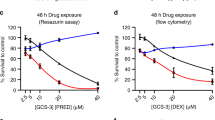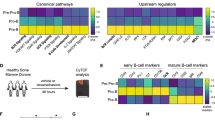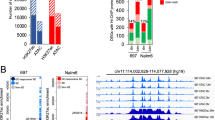Abstract
Resistance to glucocorticoids (GC) is an important adverse risk factor in the treatment of acute lymphoblastic leukemia (ALL). To induce apoptosis, GC bind to the GC receptor (GR), which is regulated by various (co)chaperone proteins such as heat-shock protein 70 (HSP-70), HSP-40, HIP (HSP-70-interacting protein), BAG-1 (BCL-2-associated gene product-1), HOP (HSP-70/HSP-90-Organizing protein), HSP-90, P-23, FKBP-51, FKBP-52 and CYP-40. In this study, we tested the hypothesis that mRNA expression levels of these molecules are determinants of GC resistance in childhood ALL. In all, 20 children with ALL cells in vitro sensitive to prednisolone (LC50<0.1 μg/ml) were compared each with a resistant patient (LC50>150 μg/ml), matched for immunophenotype, age and white blood cell count. mRNA expression levels of the (co)chaperone molecules were measured by quantitative real-time RT-PCR and normalized to GAPDH and RNaseP levels. In vitro resistance to prednisolone was measured by MTT assay. HSP-90 mRNA expression levels were 2000-fold higher as compared to HSP-70. Using matched pair analysis, mRNA expression levels of the various (co)chaperone molecules were not significantly different between in vitro-sensitive and -resistant patients. GC resistance in childhood ALL cannot be attributed to different mRNA expression levels of the investigated (co)chaperone molecules involved in GC binding and transport to the nucleus.
This is a preview of subscription content, access via your institution
Access options
Subscribe to this journal
Receive 12 print issues and online access
$259.00 per year
only $21.58 per issue
Buy this article
- Purchase on Springer Link
- Instant access to full article PDF
Prices may be subject to local taxes which are calculated during checkout





Similar content being viewed by others
References
Lauten M, Stanulla M, Zimmermann M, Welte K, Riehm H, Schrappe M . Clinical outcome of patients with childhood acute lymphoblastic leukaemia and an initial leukaemic blood blast count of less than 1000 per microliter. Klin Padiatr 2001; 213: 169–174.
Kaspers GJ, Pieters R, Van Zantwijk CH, Van Wering ER, Van Der Does-Van Den Berg A, Veerman AJ . Prednisolone resistance in childhood acute lymphoblastic leukemia: vitro–vivo correlations and cross-resistance to other drugs. Blood 1998; 92: 259–266.
Hongo T, Yajima S, Sakurai M, Horikoshi Y, Hanada R . In vitro drug sensitivity testing can predict induction failure and early relapse of childhood acute lymphoblastic leukemia. Blood 1997; 89: 2959–2965.
Tissing WJ, Meijerink JP, den Boer ML, Pieters R . Molecular determinants of glucocorticoid sensitivity and resistance in acute lymphoblastic leukemia. Leukemia 2003; 17: 17–25.
Pratt WB, Toft DO . Regulation of signaling protein function and trafficking by the hsp90/hsp70-based chaperone machinery. Exp Biol Med 2003; 228: 111–133.
Ratajczak T, Ward BK, Minchin RF . Immunophilin chaperones in steroid receptor signalling. Curr Top Med Chem 2003; 3: 1348–1357.
Galigniana MD, Harrell JM, Murphy PJ, Chinkers M, Radanyi C, Renoir JM et al. Binding of hsp90-associated immunophilins to cytoplasmic dynein: direct binding and in vivo evidence that the peptidylprolyl isomerase domain is a dynein interaction domain. Biochemistry 2002; 41: 13602–13610.
Davies TH, Ning YM, Sanchez ER . A new first step in activation of steroid receptors: hormone-induced switching of FKBP51 and FKBP52 immunophilins. J Biol Chem 2002; 277: 4597–4600.
Kojika S, Sugita K, Inukai T, Saito M, Iijima K, Tezuka T et al. Mechanisms of glucocorticoid resistance in human leukemic cells: implication of abnormal 90 and 70 kDa heat shock proteins. Leukemia 1996; 10: 994–999.
Lauten M, Beger C, Gerdes K, Asgedom G, Kardinal C, Welte K et al. Expression of heat-shock protein 90 in glucocorticoid-sensitive and -resistant childhood acute lymphoblastic leukaemia. Leukemia 2003; 17: 1551–1556.
Stam RW, den Boer ML, Meijerink JP, Ebus ME, Peters GJ, Noordhuis P et al. Differential mRNA expression of Ara-C-metabolizing enzymes explains Ara-C sensitivity in MLL gene-rearranged infant acute lymphoblastic leukemia. Blood 2003; 101: 1270–1276.
Meijerink J, Mandigers C, van de Locht L, Tonnissen E, Goodsaid F, Raemaekers J . A novel method to compensate for different amplification efficiencies between patient DNA samples in quantitative real-time PCR. J Mol Diagn 2001; 3: 55–61.
Den Boer ML, Harms DO, Pieters R, Kazemier KM, Gobel U, Korholz D et al. Patient stratification based on prednisolone-vincristine-asparaginase resistance profiles in children with acute lymphoblastic leukemia. J Clin Oncol 2003; 21: 3262–3268.
Pieters R, Huismans DR, Loonen AH, Hahlen K, van der Does-van den Berg A, van Wering ER et al. Relation of cellular drug resistance to long-term clinical outcome in childhood acute lymphoblastic leukaemia. Lancet 1991; 338: 399–403.
Rajapandi T, Greene LE, Eisenberg E . The molecular chaperones Hsp90 and Hsp70 are both necessary and sufficient to activate hormone binding by glucocorticoid receptor. J Biol Chem 2000; 275: 22597–22604.
Morishima Y, Murphy PJ, Li DP, Sanchez ER, Pratt WB . Stepwise assembly of a glucocorticoid receptor.hsp90 heterocomplex resolves two sequential ATP-dependent events involving first hsp70 and then hsp90 in opening of the steroid binding pocket. J Biol Chem 2000; 275: 18054–18060.
Kanelakis KC, Pratt WB . Regulation of glucocorticoid receptor ligand-binding activity by the hsp90/hsp70-based chaperone machinery. Methods Enzymol 2003; 364: 159–173.
Yufu Y, Nishimura J, Nawata H . High constitutive expression of heat shock protein 90 alpha in human acute leukemia cells. Leukemia Res 1992; 16: 597–605.
Xiao K, Liu W, Qu S, Sun H, Tang J . Study of heat shock protein HSP90 alpha, HSP70, HSP27 mRNA expression in human acute leukemia cells. J Tongji Med Univ 1996; 16: 212–216.
Kanelakis KC, Morishima Y, Dittmar KD, Galigniana MD, Takayama S, Reed JC et al. Differential effects of the hsp70-binding protein BAG-1 on glucocorticoid receptor folding by the hsp90-based chaperone machinery. J Biol Chem 1999; 274: 34134–34140.
Kanelakis KC, Murphy PJ, Galigniana MD, Morishima Y, Takayama S, Reed JC et al. hsp70 interacting protein Hip does not affect glucocorticoid receptor folding by the hsp90-based chaperone machinery except to oppose the effect of BAG-1. Biochemistry 2000; 39: 14314–14321.
Kullmann M, Schneikert J, Moll J, Heck S, Zeiner M, Gehring U et al. RAP46 is a negative regulator of glucocorticoid receptor action and hormone-induced apoptosis. J Biol Chem 1998; 273: 14620–14625.
Scammell JG, Denny WB, Valentine DL, Smith DF . Overexpression of the FK506-binding immunophilin FKBP51 is the common cause of glucocorticoid resistance in three New World primates. Gen Comp Endocrinol 2001; 124: 152–165.
Riggs DL, Roberts PJ, Chirillo SC, Cheung-Flynn J, Prapapanich V, Ratajczak T et al. The Hsp90-binding peptidylprolyl isomerase FKBP52 potentiates glucocorticoid signaling in vivo. EMBO J 2003; 22: 1158–1167.
Stavreva DA, Muller WG, Hager GL, Smith CL, McNally JG . Rapid glucocorticoid receptor exchange at a promoter is coupled to transcription and regulated by chaperones and proteasomes. Mol Cell Biol 2004; 24: 2682–2697.
Kang KI, Meng X, Devin-Leclerc J, Bouhouche I, Chadli A, Cadepond F et al. The molecular chaperone Hsp90 can negatively regulate the activity of a glucocorticosteroid-dependent promoter. Proc Natl Acad Sci USA 1999; 96: 1439–1444.
Yang WL, Nair DG, Makizumi R, Gallos G, Ye X, Sharma RR et al. Heat shock protein 70 is induced in mouse human colon tumor xenografts after sublethal radiofrequency ablation. Ann Surg Oncol 2004; 11: 399–406.
Yang X, Chernenko G, Hao Y, Ding Z, Pater MM, Pater A et al. Human BAG-1/RAP46 protein is generated as four isoforms by alternative translation initiation and overexpressed in cancer cells. Oncogene 1998; 17: 981–989.
Chen LJ, Su XW, Qiu PX, Huang YJ, Yan GM . Thermal preconditioning protected cerebellar granule neurons of rats by modulating HSP70 expression. Acta Pharmacol Sin 2004; 25: 458–461.
Ward BK, Mark PJ, Ingram DM, Minchin RF, Ratajczak T . Expression of the estrogen receptor-associated immunophilins, cyclophilin 40 and FKBP52, in breast cancer. Breast Cancer Res Treat 1999; 58: 267–280.
Giraudier S, Chagraoui H, Komura E, Barnache S, Blanchet B, LeCouedic JP et al. Overexpression of FKBP51 in idiopathic myelofibrosis regulates the growth factor independence of megakaryocyte progenitors. Blood 2002; 100: 2932–2940.
Kaspers GJ, Pieters R, Veerman AP . Glucocorticoid resistance in childhood leukemia. Int J Pediatr Hematol/Oncol 1997; 4: 583–596.
Schmidt S, Rainer J, Ploner C, Presul E, Riml S, Kofler R . Glucocorticoid-induced apoptosis and glucocorticoid resistance: molecular mechanisms and clinical relevance. Cell Death Differ 2004; 11 (Suppl 1): S45–S55.
Author information
Authors and Affiliations
Corresponding author
Rights and permissions
About this article
Cite this article
Tissing, W., Meijerink, J., den Boer, M. et al. mRNA expression levels of (co)chaperone molecules of the glucocorticoid receptor are not involved in glucocorticoid resistance in pediatric ALL. Leukemia 19, 727–733 (2005). https://doi.org/10.1038/sj.leu.2403681
Received:
Accepted:
Published:
Issue Date:
DOI: https://doi.org/10.1038/sj.leu.2403681
Keywords
This article is cited by
-
Effect of EPA on Hsp90 and GRα protein expression in multiple myeloma drug-resistant cells
BMC Cancer (2021)
-
Associations of HSP90AA2 gene polymorphisms with disease susceptibility, glucocorticoids efficacy and health-related quality of life in Chinese systemic lupus erythematosus patients
Genes & Genomics (2018)
-
Recent advances in the molecular mechanisms causing primary generalized glucocorticoid resistance
Hormones (2016)
-
Gene expression analysis in the human hypothalamus in depression by laser microdissection and real-time PCR: the presence of multiple receptor imbalances
Molecular Psychiatry (2008)
-
Unsupervised proteome analysis of human leukaemia cells identifies the Valosin-containing protein as a putative marker for glucocorticoid resistance
Leukemia (2006)



